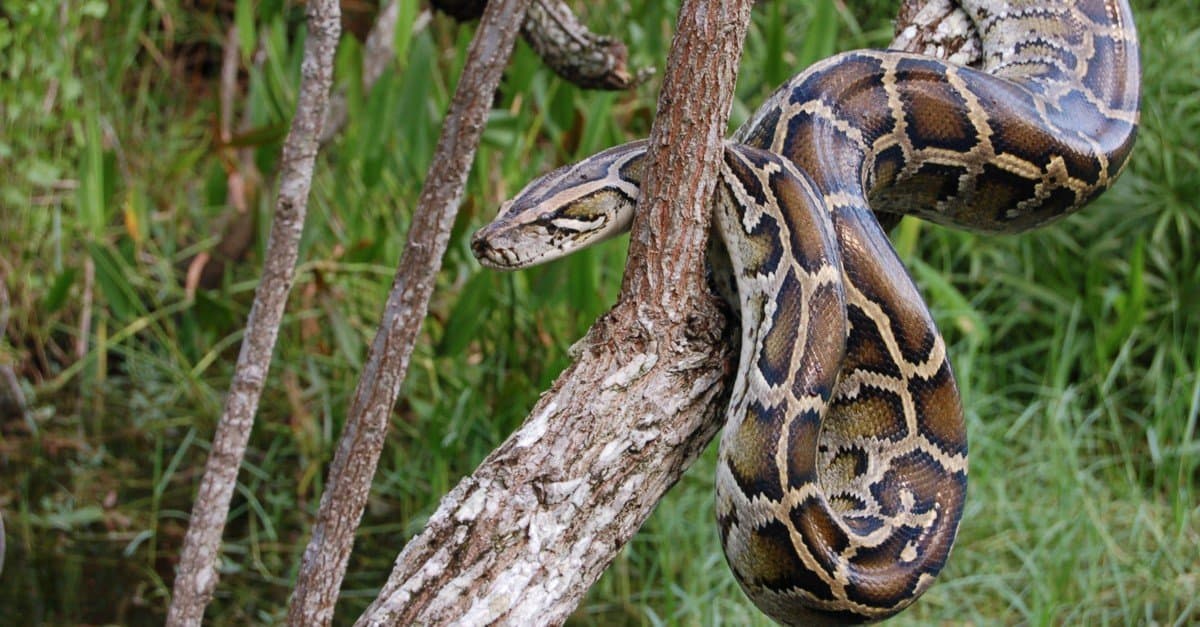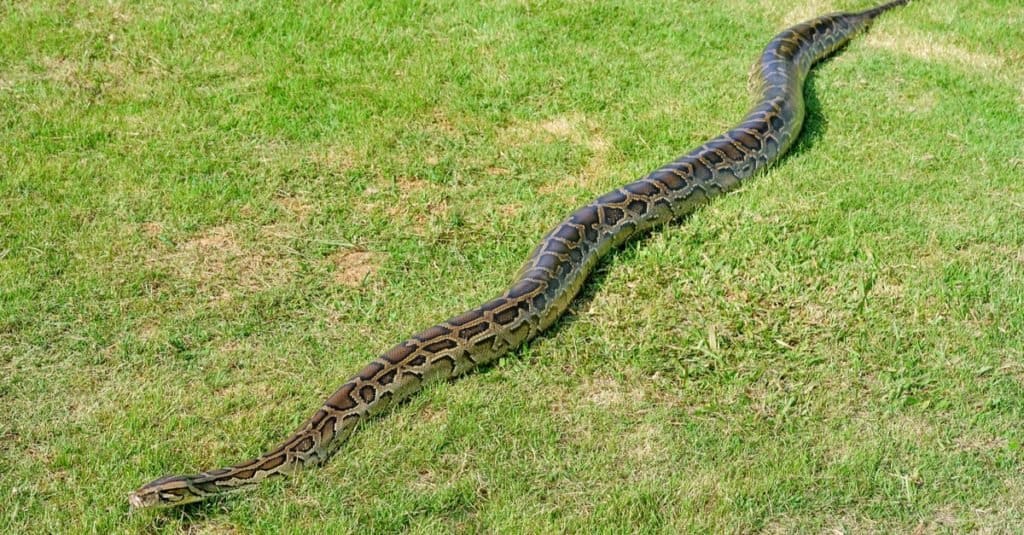The Burmese Python Mystique: A Deep Dive Into Its Life And Habitat
There’s something about the Burmese python that captivates both nature enthusiasts and casual observers alike. It’s not just a snake; it’s a symbol of raw power, adaptability, and mystery. Whether you’re fascinated by its size, intrigued by its behavior, or curious about its role in ecosystems, the Burmese python has plenty to offer. So buckle up because we’re diving deep into the world of this incredible creature, exploring its life, habitat, and everything in between.
Now, before we get too far into the details, let’s talk about why the Burmese python is such a big deal. These snakes are some of the largest in the world, capable of growing over 20 feet long! Imagine that slithering through your backyard. Yikes, right? But don’t worry; they’re usually more interested in rodents than humans. Still, their sheer size and strength make them one of the most fascinating reptiles on the planet.
As we explore the life and habitat of the Burmese python, you’ll discover how these creatures have adapted to survive in diverse environments, from their native Southeast Asia to the invasive populations in Florida. By the time you finish reading, you’ll have a newfound appreciation for this majestic snake and maybe even a little respect for its ability to thrive against all odds.
Read also:Detailed Insights Into The Vampire Diaries Soundtrack A Musical Journey Through Mystic Falls
Table of Contents
- Introduction to the Burmese Python
- Biology and Physical Characteristics
- Natural Habitat and Distribution
- Diet and Feeding Habits
- Reproduction and Life Cycle
- Invasive Species in Florida
- Conservation Efforts
- Threats to the Species
- Human Interaction and Captivity
- Interesting Facts About Burmese Pythons
Introduction to the Burmese Python
Let’s start with the basics. The Burmese python, scientifically known as Python bivittatus, is a non-venomous constrictor native to Southeast Asia. It’s famous for its massive size, intricate patterns, and ability to adapt to different environments. But what makes it stand out from other snakes? Well, for starters, it’s one of the largest snake species in the world, with some individuals reaching lengths of up to 23 feet! That’s longer than a small car.
These snakes are also known for their unique hunting techniques. They ambush prey, wrap their powerful bodies around it, and suffocate it before swallowing it whole. Yep, you heard that right—whole. No chewing, no cutting, just pure swallowing power. And while that might sound terrifying, it’s actually a crucial part of their survival strategy.
Why Study the Burmese Python?
Studying the Burmese python isn’t just about understanding its biology. It’s also about comprehending its impact on ecosystems, both in its native habitats and in areas where it’s become invasive. In places like Florida’s Everglades, the Burmese python has disrupted the natural balance, leading to declines in native wildlife populations. By learning more about these snakes, we can develop better strategies for managing their populations and protecting biodiversity.
Biology and Physical Characteristics
Now let’s dive into the biology of the Burmese python. These snakes are built for survival, with a combination of physical traits that make them formidable predators. Their bodies are covered in large, overlapping scales that provide protection and aid in movement. The patterns on their skin—usually brown, tan, and black—are perfect for camouflage in dense forests and grasslands.
One of the coolest things about Burmese pythons is their heat-sensing pits. These specialized organs allow them to detect the body heat of their prey, even in complete darkness. It’s like having built-in infrared goggles, which gives them a significant advantage when hunting at night.
Key Physical Features
- Length: Up to 23 feet
- Weight: Can exceed 200 pounds
- Coloration: Brown, tan, and black patterns
- Scales: Large, overlapping for protection
- Heat-sensing pits: For detecting prey
Natural Habitat and Distribution
The Burmese python’s natural habitat spans across Southeast Asia, including countries like Myanmar, Thailand, Vietnam, and Indonesia. They thrive in a variety of environments, from tropical rainforests to grasslands and swamps. Their adaptability is one of the reasons they’ve been so successful as an invasive species in other parts of the world.
Read also:Darcy Wretzkys Musical Odyssey And Future Outlook In 2025
In their native range, Burmese pythons play an important role in maintaining ecosystem balance. They help control rodent populations, which can prevent crop damage and the spread of diseases. However, when introduced to new areas, they can wreak havoc on local wildlife, as we’ll see later in the article.
Factors Influencing Habitat Choice
Several factors influence where Burmese pythons choose to live:
- Temperature: They prefer warm climates with plenty of sunshine.
- Water availability: Proximity to water sources is crucial for their survival.
- Food sources: Areas with abundant prey populations are ideal.
- Vegetation: Dense vegetation provides cover and protection.
Diet and Feeding Habits
When it comes to diet, the Burmese python is a true opportunist. They’ll eat pretty much anything they can overpower, including rodents, birds, reptiles, and even small mammals. Their hunting strategy is simple but effective: wait patiently, strike quickly, and constrict their prey until it stops breathing.
Interestingly, Burmese pythons can survive for months without eating after a big meal. This adaptation allows them to endure periods of food scarcity and travel long distances in search of new prey.
Common Prey Items
- Rodents: Rats, mice, and other small mammals
- Birds: Both terrestrial and aquatic species
- Reptiles: Lizards, snakes, and turtles
- Small mammals: Rabbits, opossums, and raccoons
Reproduction and Life Cycle
Reproduction is another fascinating aspect of the Burmese python’s life. These snakes are oviparous, meaning they lay eggs rather than giving birth to live young. During the breeding season, males and females engage in complex courtship behaviors, including tail rubbing and pheromone signaling.
Once mating is complete, the female lays a clutch of eggs, usually between 12 and 36, and coils around them to keep them warm. She’ll stay with the eggs until they hatch, which can take anywhere from 60 to 90 days. After hatching, the baby pythons are completely independent and must fend for themselves.
Invasive Species in Florida
Perhaps the most well-known issue surrounding the Burmese python is its status as an invasive species in Florida. Introduced to the Everglades through the pet trade, these snakes have thrived in the warm, wet environment, leading to significant ecological problems. They’ve been linked to declines in populations of native species, including raccoons, opossums, and even deer.
Efforts to control the python population in Florida have included hunting programs, public awareness campaigns, and research into effective removal techniques. While progress has been made, the challenge remains significant due to the snake’s elusive nature and rapid reproduction rate.
Impact on Native Wildlife
- Decline in small mammal populations
- Disruption of food chains
- Loss of biodiversity
- Increased risk to endangered species
Conservation Efforts
Conserving the Burmese python in its native habitat is just as important as controlling its invasive populations. In Southeast Asia, habitat destruction and illegal wildlife trade pose significant threats to the species. Conservationists are working to address these issues through habitat restoration, anti-poaching measures, and community education programs.
On the flip side, efforts to manage invasive populations in Florida focus on removing snakes from sensitive areas and preventing further introductions. Public participation plays a crucial role in these efforts, as citizens are encouraged to report sightings and participate in organized hunts.
Threats to the Species
Despite their size and strength, Burmese pythons face numerous threats in the wild. Habitat loss due to deforestation and urbanization is a major concern, as it reduces the availability of suitable environments for these snakes. Additionally, they’re often targeted by hunters for their skin, which is used in the fashion industry.
Climate change also poses a potential threat to the species, as rising temperatures and changing weather patterns could alter their habitats and prey availability. Addressing these threats requires a coordinated effort from governments, conservation organizations, and local communities.
Human Interaction and Captivity
Humans and Burmese pythons have a complicated relationship. While some people keep them as pets, others view them as dangerous invaders. In captivity, these snakes can live for over 20 years and require specialized care, including large enclosures, appropriate temperature and humidity levels, and a steady diet of appropriately sized prey.
However, owning a Burmese python isn’t without risks. Their size and strength make them potentially dangerous, especially if they feel threatened or stressed. As a result, many experts recommend against keeping them as pets unless you have extensive experience with reptiles.
Interesting Facts About Burmese Pythons
Here are a few fun facts about Burmese pythons that might surprise you:
- They can swim for extended periods and are often found near water sources.
- Some individuals have been known to eat animals as large as alligators!
- Despite their size, they’re surprisingly fast and agile when hunting.
- They’re capable of shedding their skin multiple times per year.
Conclusion
As we wrap up our deep dive into the world of the Burmese python, it’s clear that this incredible creature deserves both our admiration and our respect. From its impressive physical characteristics to its role in ecosystems, the Burmese python is a true marvel of nature. However, its invasive populations in places like Florida highlight the importance of responsible pet ownership and conservation efforts.
We encourage you to share this article with friends and family who might be interested in learning more about these fascinating snakes. And if you’ve got any questions or comments, feel free to drop them below. Together, we can continue to explore the mysteries of the natural world and work towards a better future for all species.


